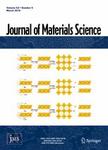版权所有:内蒙古大学图书馆 技术提供:维普资讯• 智图
内蒙古自治区呼和浩特市赛罕区大学西街235号 邮编: 010021

作者机构:Sun Yat Sen Univ State Key Lab Optoelect Mat & Technol Guangzhou 510275 Guangdong Peoples R China Guangdong Med Coll Sch Informat Engn Dongguan 523808 Peoples R China
出 版 物:《JOURNAL OF MATERIALS SCIENCE》 (材料科学杂志)
年 卷 期:2014年第49卷第15期
页 面:5299-5308页
核心收录:
学科分类:08[工学] 0805[工学-材料科学与工程(可授工学、理学学位)]
基 金:The National Basic Research Program of China [2014CB931700] National Natural Science Foundation of China [81071264, 61071039] Project Science and Technology of Guangdong Province [1012210400369, 10251027501000013] Project Science and Technology of Guangzhou City [2010planD00011] Youth Science Foundation of Guangdong Medical College [XQ1030]
主 题:FIBRINOGEN RESEARCH BLOOD platelet activation ADSORPTION (Biology) SURFACE topography MICROARRAY technology TITANIUM dioxide CARBON films MICROSTRUCTURE
摘 要:This study systematically investigated the synergistic effect of material s surface topography and electronic structure on fibrinogen adsorption and platelet activation. Three kinds of oriented TiO2 nanorod arrays (TNA) were synthesized by the hydrothermal method by changing the growth parameters in order to adjust the surface topography and roughness. The carbon thin films with various sp(3) C contents were deposited onto the top of TNA with the DC magnetic-filtered cathodic vacuum arc deposition. The structure, the surface topography, and the roughness of TNA were characterized by X-ray diffraction, scanning electron microscopy, and atomic force microscopy, respectively. The sp(3) C content in carbon films was estimated using Raman spectroscopy. The results demonstrated that the amount of fibrinogen adsorbed on surface was influenced merely by surface topography and roughness of TNA, but independent of surface carbon coating. In addition, the platelet adhesion decreased significantly with the increase of the sp(3) C content in carbon coating at the same degree of roughness or adsorbed fibrinogen. The lowest platelet adhesion and activation was observed on the specific surface topography associated with the highest sp(3) C content in carbon coating.